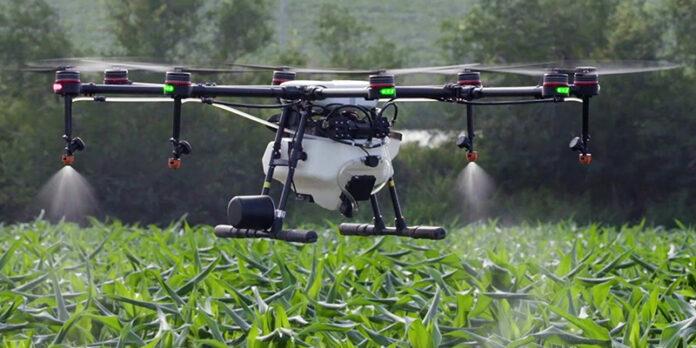- Advertisement -
By M Atif Ismail
MULTAN, Apr 27 (APP): The introduction of drone technology has the potential to revolutionize the sugarcane sector in Pakistan by reducing costs, increasing productivity, and promoting environmental safety, said agricultural scientists and sugarcane experts Dr. Asif Tanveer and Dr. Shahid Afghan while talking to APP.
They emphasized that urgent adoption of this precision agriculture tool could help Pakistan achieve its goal of becoming one of the world’s leading sugarcane producers while doubling farmers’ income.
According to Dr. Asif Tanveer, the sugarcane sector faces serious structural challenges, including low productivity of around 750 maunds per acre, uneconomic landholding size of less than five acres, poor input use efficiency, high pest losses, and minimal mechanization. He said drone technology offers a way out by ensuring precise and need-based application of fertilizers and pesticides, boosting input use efficiency, lowering production costs, and protecting farmer health.
Dr. Tanveer highlighted that drones, once seen as hobbyist tools, are now extensively used in agriculture, especially for crop scouting and spraying operations. He noted that commercial production of spray drones has made it feasible for farmers to adopt this technology at reasonable costs. “There is a labor shortage for timely fertilizer and pesticide application in sugarcane fields. Drone spraying can address this gap, while also reducing environmental pollution and health risks associated with conventional pesticide use,” he stated.
Dr. Shahid Afghan added that conventional spraying methods expose farm workers and their families to dangerous chemicals, leading to serious health problems like cancer, asthma, and neurological disorders. He stressed that drones offer a safer, environmentally friendly alternative, capable of protecting both the crop and human health.
Dr. Asif Tanveer informed that currently, farmers spend about Rs. 1000 per acre for manual spraying, using about 120 liters of water. Drone spraying reduces the water requirement to just 10 liters per acre, a 90 percent saving, while lowering the spray cost to around Rs. 800 per acre compared to Rs. 1500 by tractor sprayers. Drones can spray during the day or night and complete one acre of spraying in just 5–10 minutes, compared to 4–5 hours manually.
He further explained that when spreading fertilizer manually, one person needs a full day to cover eight acres, but with a drone, the same task can be completed in an hour, and the liquid fertilizer is distributed more evenly. The operational cost of using liquid fertilizer is also lower than that of solid fertilizer, helping farmers maximize economic benefits at minimal cost.
Dr. Tanveer revealed that the absorption rate of traditional dry nitrogen fertilizer is only about 30 percent, while nano urea, which can be sprayed through drones, is absorbed up to 86 percent by crops. “Drone spraying has reduced the use of fertilizers and pesticides by 25 to 50 percent, saving up to 40 percent of total input costs while boosting yield by 10 to 30 percent,” he added.
Sharing findings from recent studies, he stated that drone spraying results in 75 to 90 percent savings in insecticide use compared to hand and tractor spraying, respectively. Likewise, water savings reached 50 to 75 percent, and overall time savings were 69 percent compared to hand spraying and 50 percent compared to tractor spraying. “Drone sprayers also cut 50 percent of expenditures compared to traditional methods,” he remarked.
Dr. Shahid Afghan underlined the additional advantages of drone technology in precision herbicide application. He pointed out that drones can generate geo-referenced images of sugarcane fields to identify weed infestation spots, allowing for localized spraying and up to 85 percent reduction in herbicide use. “In manual spraying, laborers often miss or re-spray areas unnecessarily. Drones ensure precise coverage with no overlap,” he said.
Moreover, Dr. Tanveer explained that drones’ artificial intelligence systems adjust spraying directions based on wind conditions, maintaining spray uniformity and minimizing drift and environmental contamination.
Addressing challenges faced by traditional methods, Dr. Asif Tanveer said tractors can only be used for fertilizer application when the sugarcane plants are less than one meter tall. During the rainy season, fields become too muddy for tractors, forcing farmers to revert to difficult manual operations. When sugarcane grows to two meters or taller, it becomes even more impractical for manual laborers to work effectively. Dense sugarcane foliage also poses health risks to workers. “Drones provide a comprehensive solution to these problems, ensuring uniform and efficient application of inputs even at later crop stages,” he stressed.
Highlighting wastage in conventional spraying, Dr. Tanveer pointed out that large pesticide droplets often fall off the leaves, leading to wastage of up to 50 percent. Drones, however, spray fine droplets directly onto leaves, enhancing absorption and reducing wastage dramatically.
He said drones equipped with cameras and sensors can also monitor crop health by identifying water stress, pest attacks, and nutrient deficiencies early. This allows farmers to take timely corrective action, improve yields, and lower costs. Drones are also crucial for biological pest control, helping to quickly release natural predators at precise locations.
Looking ahead, Dr. Shahid Afghan said sugar mills could use drones for crop scouting, mapping sugarcane acreage, conducting NDVI analysis for plant health, assessing soil nutrients, monitoring irrigation, and predicting harvesting time based on crop maturity. This would result in better quality sugarcane and improved sugar production, potentially increasing CCS (Commercial Cane Sugar) content from 10 to 12 percent.
Dr. Asif Tanveer stressed that to achieve national goals for sugarcane production and farmer income growth, Pakistan must urgently embrace digital and precision agriculture technologies like drones.
He urged sugar mills, service providers, and farmers’ associations to collaborate and launch large-scale initiatives to promote drone use in sugarcane farming. “There is a need to conduct surveys and directly meet farmers across central and southern Punjab, Khyber Pakhtunkhwa and Sindh to spread awareness about the benefits of drone technology,” Dr. Tanveer concluded, adding that widespread adoption will transform Pakistan’s sugarcane industry and make it globally competitive.

